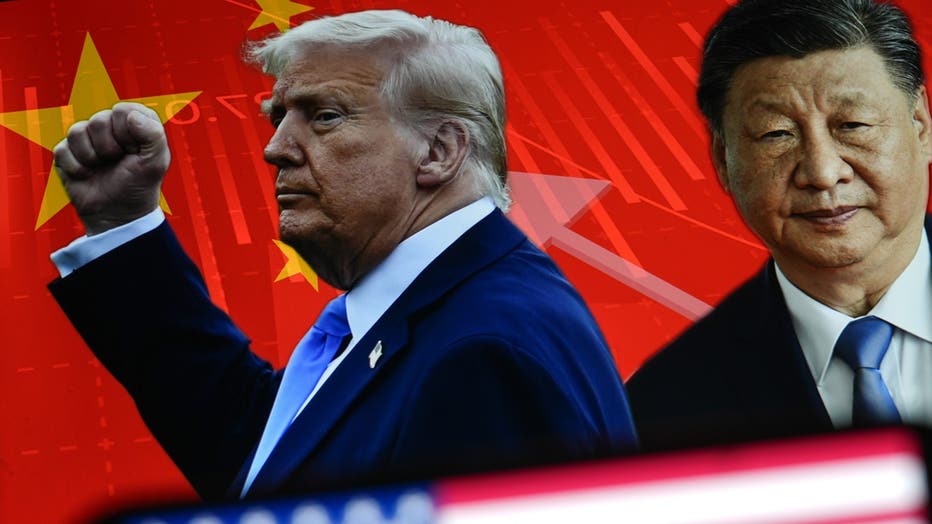China’s rare earth minerals included in new trade deal, Trump says

President Trump to resumes talks with China on trade
President Donald Trump and Chinese President Xi Jinping are expected to talk soon to work through trade disagreements, especially about important minerals, according to Treasury Secretary Scott Bessent on Sunday. Last Friday, Trump said China broke a deal with the U.S. by not following through on their agreement to ease tariffs and trade limits on these key minerals. Jack Burnham with the FDD weighs in.
A trade deal between the U.S. and China was announced late Tuesday after two days of talks between the two countries.
Trump’s trade deal with China
The backstory:
President Donald Trump and Chinese President Xi Jinping met in London earlier this week in hopes of reaching a trade deal.
A trade and tariff dispute between the two escalated earlier this year, roiling the global economy and sparking fears of a recession.
RELATED: Retailers shift supply chains to reduce risks from Trump’s tariffs on China
Previously:
The two countries announced May 12 after talks in Switzerland they had agreed to a 90-day suspension of most of the 100%-plus tariffs they had imposed on each other.

FILE - A photo illustration of portraits of U.S. President Donald Trump and Chinese President Xi Jinping with the Chinese and American flags. (Photo by Dilara Irem Sancar/Anadolu via Getty Images)
The new deal:
President Trump announced Wednesday that the United States will get magnets and rare earth minerals from China under a new trade deal and that tariffs on Chinese goods will rise to 55%.
In return, Trump said, the U.S. will provide China "what was agreed to," including allowing Chinese students to attend American colleges and universities.
The Republican president had recently begun to clamp down on the presence of Chinese nationals on U.S. college campuses.
RELATED: Judge temporarily blocks Trump’s latest ban on Harvard’s international students
What they're saying:
"OUR DEAL WITH CHINA IS DONE, SUBJECT TO FINAL APPROVAL WITH PRESIDENT XI AND ME.," Trump wrote Wednesday on his social media site.
"WE ARE GETTING A TOTAL OF 55% TARIFFS, CHINA IS GETTING 10%. RELATIONSHIP IS EXCELLENT!" Trump wrote.
China rare earth minerals
Big picture view:
Rare earth elements are important ingredients in electric vehicles, powerful magnets, advanced fighter jets, submarines, smartphones, television screens and many other products.
China has tremendous power over the rare earths market and supplies nearly 90% of the world’s rare earths because it also is home to most of the processing capacity.
Dig deeper:
Despite their name, the 17 elements aren’t actually rare, but it’s hard to find them in a high enough concentration to make a mine worth the investment.
For context:
The U.S. has one rare earth mine, the Mountain Pass mine in California, which yields neodymium and praseodymium. These are the main components of the permanent rare earth magnets in EVs and wind turbines.
By the numbers:
China has the biggest mines, producing 297,624 tons of minerals last year compared to the 45,000 tons mined in the U.S.
China forced labor accusations
Meanwhile:
An international rights group, Global Rights Compliance, said this week that several major global companies are at risk of being linked to titanium sourced from the far-western Xinjiang region of China.
Rights groups allege rare earths from this area come from the area’s forced labor camps that allegedly target predominantly Muslim Uyghurs and other Turkic minorities, in which Uyghurs are forced to work in factories as part of a long-standing campaign of assimilation and mass detention.
The other side:
Asked about the report, the Chinese Foreign Ministry said that "no one has ever been forcibly transferred in China’s Xinjiang under work programs."
The Source: Information in this article was taken from an announcement made by senior U.S. and Chinese negotiators, and reported by The Associated Press. Background information about rare earth mining in U.S. and China was also taken from The Associated Press. This story was reported from Detroit.

